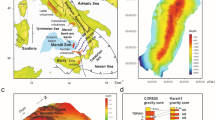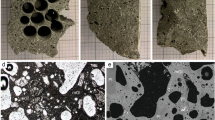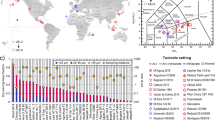Abstract
The deposits from explosive volcanic eruptions (those eruptions that release mechanical energy over a short time span1) are characterized by an abundance of volcanic ash2,3. This ash is produced by fragmentation of the magma driving the eruption and by fragmenting and ejecting parts of the pre-existing crust (host rocks). Interactions between rising magma and the hydrosphere (oceans, lakes, and ground water) play an important role in explosive volcanism4,5, because of the unique thermodynamic properties of water that allow it to very effectively convert thermal into mechanical energy. Although the relative proportion of magma to host-rock fragments is well preserved in the pyroclastic rocks deposited by such eruptions, it has remained difficult to quantitatively assess the interaction of magma with liquid water from the analysis of pyroclastic deposits2,3,4,5. Here we report the results of a study of natural pyroclastic sequences combined with scaled laboratory experiments. We find that surface features of ash grains can be used to identify the dynamic contact of magma with liquid water. The abundance of such ash grains can then be related to the water/magma mass ratios during their interaction.
This is a preview of subscription content, access via your institution
Access options
Subscribe to this journal
Receive 51 print issues and online access
$199.00 per year
only $3.90 per issue
Buy this article
- Purchase on Springer Link
- Instant access to full article PDF
Prices may be subject to local taxes which are calculated during checkout


Similar content being viewed by others
References
Freundt,A. & Rosi,M. (eds) From Magma to Tephra (Elsevier, Amsterdam, 1998).
Fisher,R. V. & Schmincke, H.-U. Pyroclastic Rocks (Springer, Berlin, 1984).
Heiken,G. & Wohletz,K. Volcanic Ash (University of California Press, Berkeley, 1985).
Wohletz,K. H. Explosive magma–water interactions: thermodynamics, explosion mechanisms, and field studies. Bull. Volcanol. 48, 245–264 (1986).
Lorenz,V. Phreatomagmatism and its relevance. Chem. Geol. 62, 149–156 (1987).
Zimanowski,B. in From Magma to Tephra (eds Freundt, A. & Rosi, M.) 25–54 (Elsevier, Amsterdam, 1998).
Lorenz,V. Vesiculated tuffs and associated features. Sedimentology 21, 273–291 (1974).
Frazzetta,G., La Volpe,L. & Sheridan,M. F. Evolution of the Fossa cone, Vulcano. J. Volcanol. Geotherm. Res. 17, 329–360 (1983).
Cas,R. A. F. & Wright,J. V. Volcanic Successions 528 (Unwin Hyman, London, 1987).
Dellino,P., Frazzetta,G. & La Volpe,L. Wet surge deposits at La Fossa di Vulcano: depositional and eruptive mechanisms. J. Volcanol. Geotherm. Res. 43, 215–233 (1990).
De Rosa,R., Frazzetta,G. & La Volpe,L. An approach for investigating the depositional mechanism of fine-grained surge deposits. The example of the dry surge deposits at “La Fossa di Vulcano”. J. Volcanol. Geotherm. Res. 51, 305–321 (1991).
Wohletz,K. H. Mechanisms of hydrovolcanic pyroclast formation: grain-size, scanning electron microscopy, and experimental studies. J. Volcanol. Geotherm. Res. 17, 31–64 (1983).
Zimanowski,B., Büttner,R., Lorenz,V. & Häfele, H.-G. Fragmentation of basaltic melt in the course of explosive volcanism. J. Geophys. Res. 102, 803–814 (1997).
De Astis,G., La Volpe,L., Peccerillo,A. & Civetta,L. Volcanological and petrological evolution of Vulcano island (Aeolian Arc, southern Tyrrhenian Sea). J. Geophys. Res. 102, 8021–8050 (1997).
Zimanowski,B., Büttner,R. & Lorenz,V. Premixing of magma and water in MFCI experiments. Bull. Volcanol. 58, 491–495 (1997).
Gioncada,A. et al. A study of melt inclusions at Vulcano (Aeolian Islands, Italy): insights on the primitive magmas and on the volcanic feeding system. Bull. Volcanol. 60, 286–306 (1998).
Dellino,P. & La Volpe,L. Fragmentation versus transportation mechanisms in the pyroclastic sequence of Monte Pilato–Rocche Rosse (Lipari, Italy). J. Volcanol. Geotherm. Res. 64, 211–232 (1995).
Büttner,R. & Zimanowski,B. Physics of thermohydraulic explosions. Phys. Rev. E 57, 5726–5729 (1998).
Acknowledgements
We thank K. Wohletz for his help in improving the quality of this Letter. This work was part of the EC Project “The physics of explosive volcanism”, supported by the European Community.
Author information
Authors and Affiliations
Corresponding author
Rights and permissions
About this article
Cite this article
Büttner, R., Dellino, P. & Zimanowski, B. Identifying magma–water interaction from the surface features of ash particles. Nature 401, 688–690 (1999). https://doi.org/10.1038/44364
Received:
Accepted:
Issue Date:
DOI: https://doi.org/10.1038/44364
This article is cited by
-
Late Quaternary explosive phonolitic volcanism of Petite-Terre (Mayotte, Western Indian Ocean)
Bulletin of Volcanology (2024)
-
Controls on juvenile ash morphologies in lava fountains: insights from laboratory experiments
Bulletin of Volcanology (2023)
-
Distinction between hydro-magmatic and magmatic fragmentations using volcanic glass shards of Youngest Toba Tuff (YTT, 75 ka) eruption, Padang Terap river basin, and Lenggong valley, Peninsular Malaysia: special emphasis on paleoenvironmental conditions
Arabian Journal of Geosciences (2022)
-
Standardized analysis of juvenile pyroclasts in comparative studies of primary magma fragmentation; 1. Overview and workflow
Bulletin of Volcanology (2022)
-
Standardized analysis of juvenile pyroclasts in comparative studies of primary magma fragmentation: 2. Choice of size fraction and method optimization for particle cross-sections
Bulletin of Volcanology (2022)
Comments
By submitting a comment you agree to abide by our Terms and Community Guidelines. If you find something abusive or that does not comply with our terms or guidelines please flag it as inappropriate.



